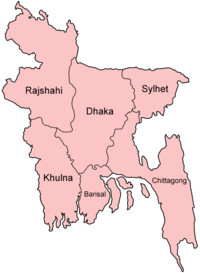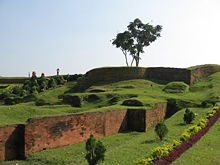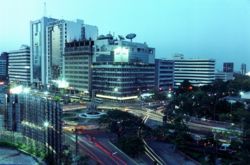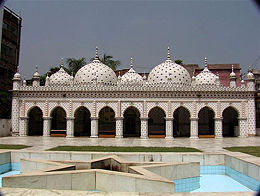|
|
| History of Bangladesh
 Bangladesh Map Bangladesh Map
Remnants of civilisation in the greater Bengal region date back four thousand years, when the region was settled by Dravidian, Tibeto-Burman, and Austro-Asiatic peoples. The exact origin of the word "Bangla" or "Bengal" is unknown, though it is believed to be derived from Bang, the Dravidian-speaking tribe that settled in the area around the year 1000 BC.
After the arrival of Indo-Aryans, the kingdom of Gangaridai was formed from at least the seventh century BC, which later united with Bihar under the Magadha and Maurya Empires. Bengal was later part of the Gupta Empire from the third to the sixth centuries CE. Following its collapse, a dynamic Bengali named Shashanka founded an impressive yet short-lived kingdom. Shashanka is considered the first independent king in the history of Bangladesh. After a period of anarchy, the Buddhist Pala dynasty ruled the region for four hundred years, followed by a shorter reign of the Hindu Sena dynasty. Islam was introduced to Bengal in the twelfth century by Sufi missionaries, and subsequent Muslim conquests helped spread Islam throughout the region. Bakhtiar Khilji, a Turkish general, defeated Lakshman Sen of the Sena dynasty and conquered large parts of Bengal. The region was ruled by dynasties of Sultans and feudal lords for the next few hundred years. By the 16th century, the Mughal Empire controlled Bengal, and Dhaka became an important provincial centre of Mughal administration.
European traders arrived late in the 15th century, and their influence grew until the British East India Company gained control of Bengal following the Battle of Plassey in 1757.The bloody rebellion of 1857, known as the Sepoy Mutiny, resulted in transfer of authority to the crown, with a British viceroy running the administration. During colonial rule, famine racked the Indian subcontinent many times, including the Great Bengal famine of 1943 that claimed 3 million lives.
Between 1905 and 1911, an abortive attempt was made to divide the province of Bengal into two zones, with Dhaka being the capital of the eastern zone. When India was partitioned in 1947, Bengal was partitioned along religious lines, with the western part going to India and the eastern part joining Pakistan as a province called East Bengal (later renamed East Pakistan), with its capital at Dhaka.
Major population in Bangladesh |
| City | City population | Metro population |
|---|
| Dhaka | 11,918,442 | 23,024,863 |
| Chittagong | 6,920,222 | 11,256,369 |
| Khulna | 3,400,689 | 8,492,659 |
| Rajshahi | 2,727,083 | 4,983,641 |
| Sylhet | 1,339,368 | 2,658,025 |
| Barisal | 1,291,769 | 2,365,125 |
In 1950, land reform was accomplished in East Bengal with the abolishment of the feudal zamindari system. However, despite the economic and demographic weight of the east, Pakistan's government and military were largely dominated by the upper classes from the west. The Bengali Language Movement of 1952 was the first sign of friction between the two wings of Pakistan. Dissatisfaction with the central government over economic and cultural issues continued to rise through the next decade, during which the Awami League emerged as the political voice of the Bengali-speaking population. It agitated for autonomy in the 1960s, and in 1966, its president Sheikh Mujibur Rahman was jailed; he was released in 1969 after an unprecedented popular uprising.
In 1970, a massive cyclone devastated the coast of East Pakistan, and the central government responded poorly. The Bengali population's anger was compounded when Sheikh Mujibur Rahman, whose Awami League won a majority in Parliament in the 1970 elections, was blocked from taking office. After staging compromise talks with Mujib, President Yahya Khan arrested him on the early hours of March 26, 1971, and launched Operation Searchlight, a sustained military assault on East Pakistan. Yahya's methods were extremely bloody, and the violence of the war resulted in many civilian deaths .[17] Chief targets included intellectuals and Hindus, and about ten million refugees fled to neighbouring India (LaPorte,[18] p. 103). Estimates of those massacred throughout the war range from three hundred thousand to 3 million.[19]
 Mahasthangarh Mahasthangarh
Most of the Awami League leaders fled and set up a government-in-exile in Calcutta, India. The Bangladesh Liberation War lasted for nine months. The guerrilla Mukti Bahini and Bengali regulars eventually received support from the Indian Armed Forces in December 1971. The Indian army, under the command of Lt. General J.S. Aurora, achieved a decisive victory over Pakistan on 16 December, 1971, taking over 90,000 prisoners of war in the Indo-Pakistani War of 1971.
After its independence, Bangladesh became a parliamentary democracy, with Mujib as the Prime Minister. In the 1973 parliamentary elections, the Awami League gained an absolute majority. A nationwide famine occurred during 1973 and 1974, and in early 1975, Mujib initiated a one-party socialist rule with his newly formed BAKSAL. On August 15, 1975, Mujib and his family were assassinated by mid-level military officers.
Government and Politics
Bangladesh is a parliamentary democracy with Islam as the state religion. Direct elections involving all citizens over the age 18 are held every five years for the unicameral parliament known as Jatia Sangsad. The parliament building is known as the Jatiyo Sangshad Bhaban designed by architect Louis Kahn and currently has 345 members including 45 reserved seats for women, elected from single-member constituencies. The Prime Minister, as the head of government, forms the cabinet and runs the day-to-day affairs of state. While the Prime Minister is formally appointed by the President, he or she must be an MP who commands the confidence of the majority of parliament. The President is the head of state, a largely ceremonial post elected by the parliament.[24]
However the President's powers are substantially expanded during the tenure of a caretaker government, which is responsible for the conduct of elections and transfer of power. The officers of the caretaker government must be non-partisan and are given three months to complete their task. This transitional arrangement is an innovation that was pioneered by Bangladesh in its 1991 election and then institutionalised in 1996 through its 13th constitutional amendment.
The Constitution of Bangladesh was drafted in 1972 and has undergone fourteen amendments. The highest judicial body is the Supreme Court. Justices are appointed by the President. The judicial and law enforcement institutions are weak. Separation of powers, judicial from executive was finally implemented on the 1st of November, 2007. It is expected that this separation will make the judiciary stronger and impartial. Laws are loosely based on English common law, but family laws such as marriage and inheritance are based on religious scripts, and therefore differ between religious communities.
Foreign Policy and Military
Bangladesh pursues a moderate foreign policy that places heavy reliance on multinational diplomacy, especially at the United Nations. In 1974 Bangladesh joined both the Commonwealth of Nations and the United Nations and has since been elected to serve two terms on the Security Council in 1978-1979 and 2000–2001. In the 1980s, Bangladesh played a lead role in founding the South Asian Association for Regional Cooperation (SAARC) in order to expand relations with other South Asian states. Since the founding of SAARC 1985, a Bangladeshi has held the post of Secretary General on two occasions.
Bangladesh's most important and complex foreign relationships are with India and Pakistan. These relationships are informed by historical and cultural ties and form an important part of the domestic political discourse.
|
 |
National symbols of Bangladesh
| Anthem | Amar Shonar Bangla |
|---|
| Animal | Royal Bengal Tiger |
|---|
| Flower | White Water Lily |
|---|
| Bird | Oriental Magpie Robin |
|---|
| Fish | Hilsa |
|---|
| Fruit | Jackfruit |
|---|
| Sport | Kabadi |
|---|
| Calendar | Bengali calendar |
|---|
Geography and Climate
Bangladesh is located in the low-lying Ganges-Brahmaputra River Delta or Ganges Delta. This delta is formed by the confluence of the Ganges (local name Padma or Pôdda), Brahmaputra (Jamuna or Jomuna), and Meghna rivers and their respective tributaries. The Ganges unites with the Jamuna (main channel of the Brahmaputra) and later joins the Meghna to eventually empty into the Bay of Bengal. The alluvial soil deposited by these rivers has created some of the most fertile plains in the world. Bangladesh has 58 trans-boundary rivers, making water issues politically complicated to resolve - in most cases as the lower riparian state to India. Most parts of Bangladesh are less than 12 metres (39 ft) above the sea level, and it is believed that about 50% of the land would be flooded if the sea level were to rise by a metre (3 ft).
The highest point in Bangladesh is in Mowdok range at 1,052 metres (3,451 ft) in the Chittagong Hill Tracts to the southeast of the country. A major part of the coastline comprises a marshy jungle, the Sundarbans, the largest mangrove forest in the world and home to diverse flora and fauna, including the Royal Bengal Tiger. In 1997, this region was declared endangered.
Straddling the Tropic of Cancer, Bangladeshi climate is tropical with a mild winter from October to March, a hot, humid summer from March to June. A warm and humid monsoon season lasts from June to October and supplies most of the country's rainfall. Natural calamities, such as floods, tropical cyclones, tornadoes, and tidal bores occur almost every year, combined with the effects of deforestation, soil degradation and erosion. Cox's Bazar, south of the city of Chittagong, has a beach that stretches uninterrupted over 120 kilometres (75 mi).

Dhaka City
In September 1998 Bangladesh saw the most severe flooding the modern world has seen. As the Brahmaputra, Ganges and Meghna spilt over and swallowed 300,000 houses, 6,000 miles (9,700 km) of road and 1,600 miles (2,600 km) of embankment 1,000 people were killed and 30 million more were made homeless with 135,000 cattle killed, 50 square kilometres of land destroyed and 11,000 kilometres of roads damaged or destroyed. Two-thirds of the country was underwater. There were several reasons for the severity of the flooding. Firstly, there were unusually high monsoon rains. Secondly, the Himalayas shed off an equally unusually high amount of melt water that year. Trees that usually intercept rain water were cut down for firewood or to make space for animals.
Religion and Culture
he major religion practiced in Bangladesh is Islam (89.7%) and a sizable minority adheres to Hinduism (9.2%).[65] About 96% of the Muslims are Sunni while over 3% are Shi'a and remainders are Ahmadis. Ethnic Biharis are predominantly Shia Muslims. Other religious groups include Buddhists (0.7%, mostly Theravada), Christians (0.3%, mostly of the Roman Catholic denomination), and Animists (0.1%). Among Muslim-majority countries, Bangladesh ranks fourth after Indonesia, Pakistan and India by the number of Muslims, with over 130 million. Islam is the state religion of Bangladesh, but other religion may also be practiced in harmony.[66] Religion practiced in the region, is fairly moderate in terms of Islam in politics and fairly high in family matters mainly concerned with marriage etc.
After gaining independence, the constitution had a secular nationalist ideology created by Sheikh Mujibur Rahman, the principle of secularism was subsequently replaced by a commitment to the Islamic way of life through a series of constitutional amendments and government proclamations between 1977 and 1988. The Constitution establishes Islam as the state religion but provides for the right to practice--subject to law, public order, and morality--the religion of one's choice.

Tara Masjid
A new state for an old nation, Bangladesh has a culture that encompasses elements both old and new. The Bengali language boasts a rich literary heritage, which Bangladesh shares with the Indian state of West Bengal. The earliest literary text in Bangla is the eighth century Charyapada. Bangla literature in the medieval age was often either religious (e.g. Chandidas), or adaptations from other languages (e.g. Alaol). Bangla literature matured in the nineteenth century. Its greatest icons are the poets Rabindranath Tagore and Kazi Nazrul Islam. Bangladesh also has a long tradition in folk literature, evidenced by Maimansingha Gitika, Thakurmar Jhuli or stories related to Gopal Bhar.
The musical tradition of Bangladesh is lyrics-based (Baniprodhan), with minimal instrumental accompaniment. The Baul tradition is a unique heritage of Bangla folk music, and there are numerous other musical traditions in Bangladesh, which vary from one region to the other. Gombhira, Bhatiali, Bhawaiya are a few of the better-known musical forms. Folk music of Bengal is often accompanied by the ektara, an instrument with only one string. Other instruments include the dotara, dhol, flute, and tabla. Bangladesh also has an active heritage in North Indian classical music. Similarly, Bangladeshi dance forms draw from folk traditions, especially those of the tribal groups, as well as the broader Indian dance tradition.[68] Bangladesh produces about 80 films a year.[69] Mainstream Hindi films are also quite popular.[70] Around 200 dailies are published in Bangladesh, along with more than 1800 periodicals. However, regular readership is low, nearly about 15% of the population.[71] Bangladeshis listen to a variety of local and national radio programmes from Bangladesh Betar, as well as Bangla services from the BBC and Voice of America. There is a state-controlled television channel, but in the last few years, privately owned channels have grown considerably.
Source: Wikipedia
|
 |
|
 |
|
|
Posted By: tajuddin2/7/2010 Total views: 6722 |
blog comments powered by
|